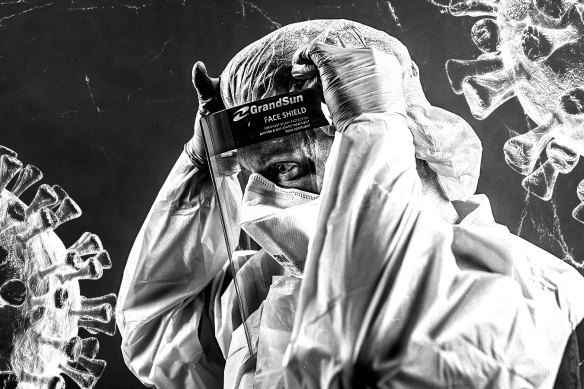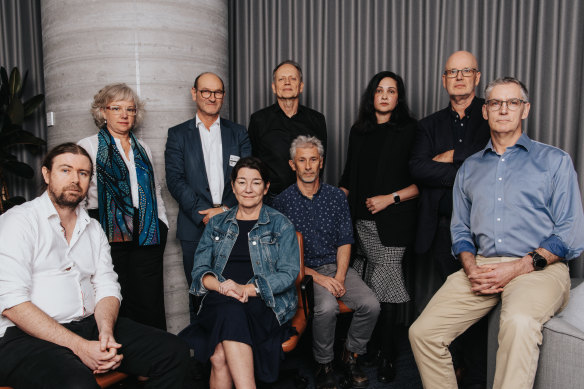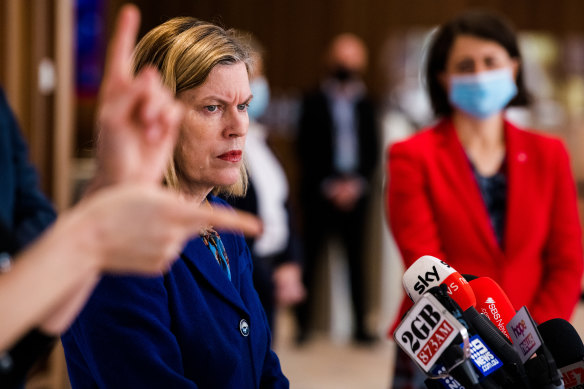This was published 9 months ago
The secrets kept from those inside the nerve centre fighting COVID
As state and federal governments fought for control of borders and information during the pandemic, some of the most vulnerable were left at risk.
By Mary Ward and Kate Aubusson

Public health experts have warned that federal and state governments must improve their collaboration processes before the next pandemic.Credit: Kate Geraghty, Aresna Villanueva
In the middle of Sydney’s Delta lockdown, St Vincent’s Hospital doctor Professor Steven Faux was pulling up in a van to an inner-city block of flats where his team believed a number of people with disabilities lived. They did not have a list of names or know how many people they would find there; all they knew was that these people had not yet received a COVID-19 vaccine.
There is a list of people living in Sydney who are on the National Disability Insurance Scheme (NDIS). But it is held by the federal government, which had elected to prioritise its already lagging rollout of the vaccine in aged care ahead of attempting to provide the vaccine to NDIS participants – a decision it was lambasted for at the disability royal commission later that year.
Using hospital records, relatives’ phone numbers, and referrals from friends, the outreach van was among the improvised state services attempting to protect the vulnerable and plug the gaps left by the federal government’s vaccine rollout as the Delta wave rolled in.
“If it wasn’t for NSW having innovative ways of vaccinating disabled people, like drive-throughs and vans going out to people, a lot of disabled people would have died,” Faux said.
Public health experts have warned that federal and state governments must improve their collaboration processes before the next pandemic. They call for better systems for sharing information and delivering services.

The Herald’s expert panel, from left: UNSW Professor James Wood, University of Sydney Professor Julie Leask, St Vincents Hospital Associate Professor Steven Faux, University of Newcastle epidemiologist Jennie Musto, Kirby Institute Scientia Professor Gregory Dore, University of Sydney Professor Nicholas Wood, University of Sydney’s Dr Jocelyne Basseal, University of Sydney Professor Eddie Holmes, University of Newcastle Conjoint Associate Professor Craig Dalton.Credit: James Brickwood
With Australia’s inquiry into the coronavirus response focusing on federal decisions, The Sydney Morning Herald is conducting its own review of decisions made at state level.
Following a panel on NSW’s education policy during the pandemic held earlier this year, this masthead assembled nine public health experts to interrogate decisions made in their field and provide recommendations ahead of what they believe is an inevitable next pandemic.
The group was scathing of logistical bungles during the COVID-19 vaccine rollout, both the delays with vaccinating vulnerable groups but also issues with supply, delivery, and communication. They recommended future vaccination efforts be managed by the NSW government whose core business is providing public health services.
National Centre for Immunisation Research and Surveillance associate director Professor Nicholas Wood said the proof this was the wrong call could be seen in how things operate today.
“Before that it was the state running things, and now we have gone back to the state running things,” he said.
University of Sydney vaccine researcher Professor Julie Leask was critical of the Morrison government’s management of the vaccine rollout instead of the usual state-based systems.
“They wanted to dominate the rollout of the vaccine for a range of reasons, and I think some of them were political,” Leask said.
She also criticised the federal government’s “arm yourself” vaccination advertising campaign, which she said would have been easily identified as problematic for some cultural groups had it been developed in consultation with local community health organisations.
South-west Sydney doctor and community leader Jamal Rifi savaged the campaign when it was launched, telling the ABC: “For years we were working with countering violent extremism, and some genius in Canberra comes in and says ‘arm yourself’. How am I going to translate this in Arabic? Arm yourself, that means get a gun.”
The COVID-19 pandemic unearthed a state government-based parochialism, the panel said, where collaboration with other states was harder than it should have been, and the hodgepodge of virus restrictions and border closures – particularly in relative “peacetime” – became confusing and unmanageable.
“Moving forward, we need to look at a national response. It’s the same virus, the same infection control measures,” said the University of Sydney’s Dr Jocelyne Basseal, who worked on the COVID-19 response for the Western Pacific region with the World Health Organisation.
When it came to collaboration between state and federal governments, UNSW infectious diseases modeller James Wood said the issues that emerged in Australia’s COVID-19 vaccine rollout were indicative of broader problems with health co-operation and communication in Australia.
“You have all these state-level resources and connections and ability to do things that took quite a long time to be taken advantage of … states weren’t provided with detailed data on vaccination coverage and gaps for a really long time,” he said.
This stifling of communication between and within agencies was another “massive problem”, Leask said.
“People, even within a Ministry of Health, aren’t briefed and kept up to date on what the thinking is about where we’re heading next, what the evidence is that informs our policy,” she said.
James Wood’s modelling, used to inform policy decisions, was tightly held, said Jennie Musto, who was operations manager of NSW Health’s Public Health Emergency Operations Centre.
“I was the head of the operations sitting [in meetings with Chief Health Officer Kerry Chant] every single day, and we didn’t get to see [that] modelling data,” Musto said.

NSW Chief Health Officer Dr Kerry Chant and then-premier Gladys Berejiklian appeared together for daily briefings during the COVID-19 crisis.Credit: James Brickwood
Despite asking for the data almost daily, it was only shared with Chant and then-premier Gladys Berejiklian.
“The explanation for exactly why we were doing things wasn’t there. It was just: ‘this is what we’re doing’,” said Musto, who speculated that the reason the modelling wasn’t shared more broadly was concern it would leak.
‘Australia doesn’t do transparency well’
It was a different approach taken to other countries during the pandemic: the UK Sage group published its meeting documents, while the US equivalent of Australia’s technical vaccine advisory group (ATAGI), the Advisory Committee on Immunisation Practices, livestreamed its meetings.
“Australia doesn’t do transparency well,” James Wood said. “Hardly any of the key documents that informed discussions [such as those used by ATAGI, of which he is a member] ever made it to light.”
Every member of the panel believed that Australia would benefit from a well-funded Centre for Diseases Control (CDC), as exists in the US.
The Albanese government committed $90.9 million in the 2023-24 federal budget to support establishing a CDC. An interim CDC was established in January. Its permanent location is not yet determined.
The Kirby Institute’s Professor Greg Dore suggested it might be necessary for states to cede some power for such a body to function.
“I’m not completely pessimistic about CDC, but it’s hamstrung by a lack of political will and investment at this stage,” he said.
University of Sydney epidemiologist Professor Eddie Holmes agreed the CDC needed to be a federal system with control: “If it’s just lip service, or a hub and spoke model and states have still got autonomy – what’s the point?”
In response to questions following the panel, federal Health Minister Mark Butler said the interim CDC was already strengthening Australia’s pandemic preparedness, particularly in relation to surveillance capabilities and use of data.
NSW Health Minister Ryan Park noted the state’s health ministry had already conducted two internal reviews of its health response.
“We are working hard to ensure the findings and recommendations from those reports are being implemented as quickly as possible, including the sharing of data and information with our state, territory and Commonwealth colleagues,” he said.
The expert panellists spoke in their academic capacity and not on behalf of NSW Health, the World Health Organisation, or ATAGI.
Start the day with a summary of the day’s most important and interesting stories, analysis and insights. Sign up for our Morning Edition newsletter.